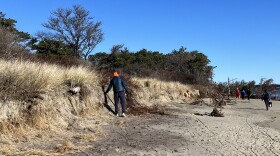On April 8, for the first time in almost 100 years, Vermont will see a total solar eclipse. The moon will completely block out the sun, leaving only the sun's corona — the outermost region of the sun’s atmosphere, named for its crownlike appearance — visible for several minutes.
Towns like St. Albans lying directly down the center of the path of totality — the line along which the darkest part of the shadow cast by the moon, called the “umbra,” moves — will experience the total eclipse for the longest duration, around three and a half minutes. Towns closer to the edges like Montpelier will see it for a shorter duration. Areas outside of the path of totality will still see a partial eclipse, called the “penumbra.”
The state is expecting a large influx of visitors, with hotels and resorts fully booked, schools closing early (to let children view the eclipse), and towns preparing to host massive crowds.
Loading...
The shaded areas on the map, representing the path of totality, are shaded based on the duration of the total eclipse — the darkest area, in the center, will see the total eclipse the longest, around 3.5 minutes. The lightest area, around the edges, will still see the total eclipse, but for a shorter duration. Only locations outside of the shaded area will not see the total eclipse.
You can keep up with Vermont Public's eclipse coverage here.
What goes into calculating an eclipse?
Calculating the exact path of an eclipse is complicated, said Ernie Wright, a scientific visualizer at NASA who calculated the path of the 2024 total solar eclipse. First, you need to know the position of the moon, a task made easier by a set of special mirrors called retroreflectors placed on the moon during several lunar missions, including Neil Armstrong’s Apollo 11 in 1969.
“We shoot lasers at these retroreflectors from the Earth and determine the position of the moon by the time it takes for the light to travel to the moon and come back,” Wright said. “Using that, we’re able to measure the position of the moon to within a centimeter.”
Additionally, the apparent position of the moon and the sun is affected by the time it takes light to travel, around 8 minutes from the sun to the Earth, and 1.3 seconds from the moon to the Earth. Not accounting for that, using a process called light-time correction, could throw predictions of the path of the eclipse off by miles, Wright said.
Also a factor: the shape of the moon itself. The moon’s surface is covered with mountains, craters, valleys and other features. The edges of the moon, as viewed from Earth, are called the lunar limb. As the moon shifts into or out of the path of the sun, transitioning between total and partial eclipse, the moon’s limb unevenly blocks the light, resulting in a sparkling effect known as “Baily’s beads.”
This effect is more noticeable at the edges of the umbra, which you can only know about in advance of an eclipse with a more accurate map.

Wright’s total eclipse model includes 18,000 geometric points around the edge of the moon to get a more accurate shadow, which he describes as looking like a potato.
In total, Wright’s calculations consist of over 5,000 lines of code and took several days to complete. NASA’s official map, based on those calculations, is accurate within around 200 meters, Wright said.

The data used in Vermont Public’s map, also from Wright, is accurate within about a kilometer, as it uses a simpler model — one that does not take into account the exact shape of the moon.
Have questions, comments or tips? Send us a message.
More eclipse resources
- See our eclipse liveblog for the latest updates.
- Watch our half-hour educational TV special, "Path to Totality."
- See our interactive map of the eclipse path.
- Plan for road closures around the state.
- Get updates on the weather forecast for Monday.
- Emergency management officials share travel and communication tips.
- Where to find eclipse glasses.
- Learning guides for preK-12 educators.
- Details on our live event in St. Johnsbury and other events around the state.
See all of Vermont Public's 2024 eclipse coverage.




